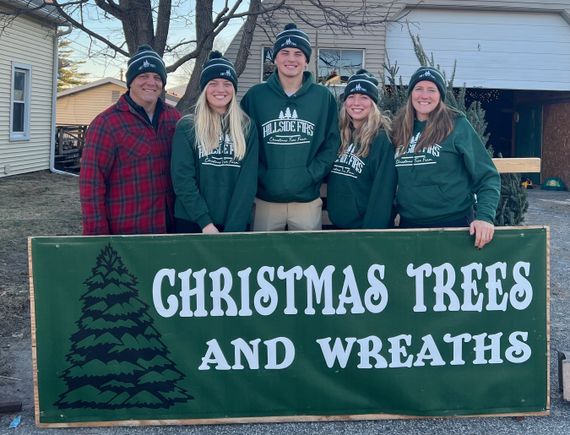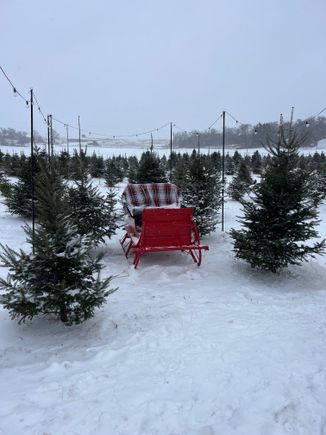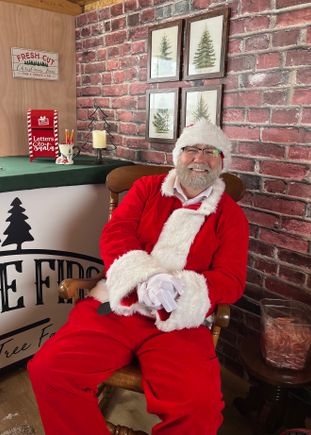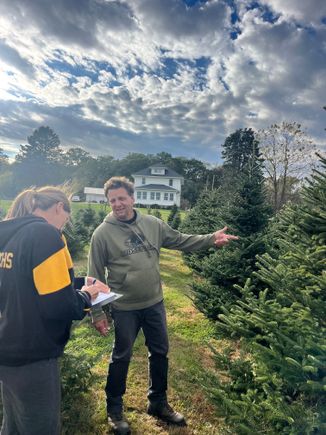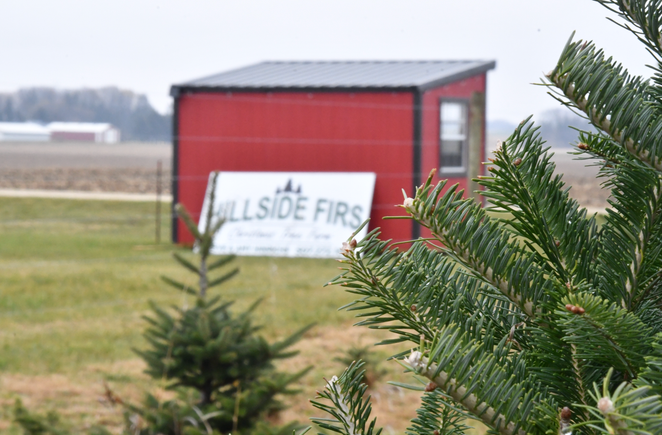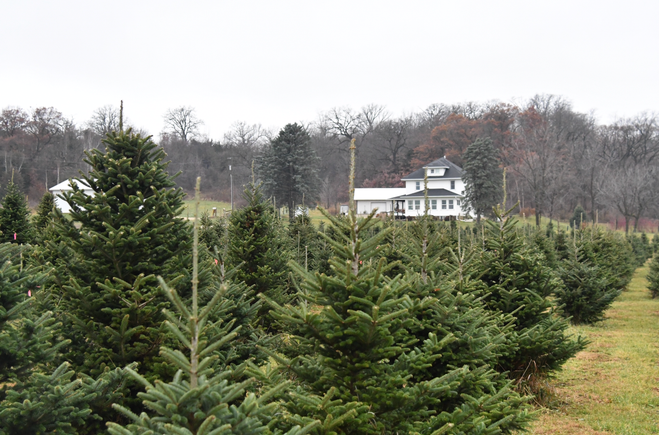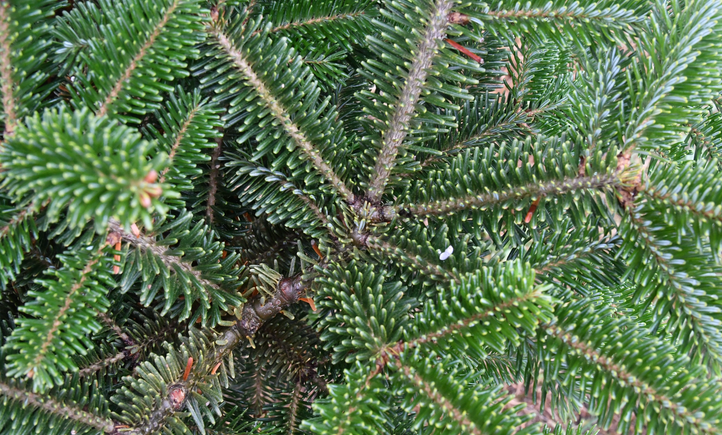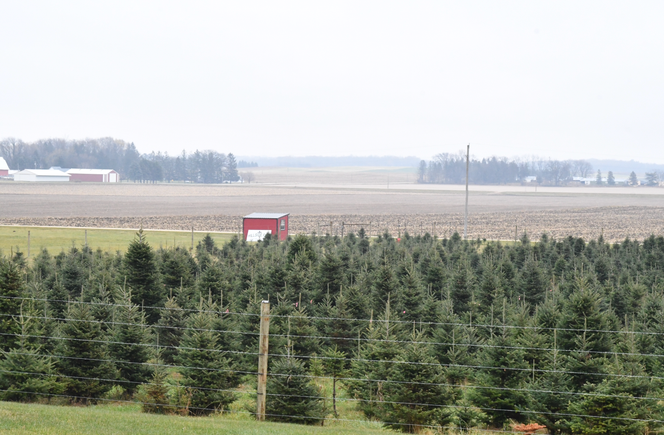Film-worthy farm
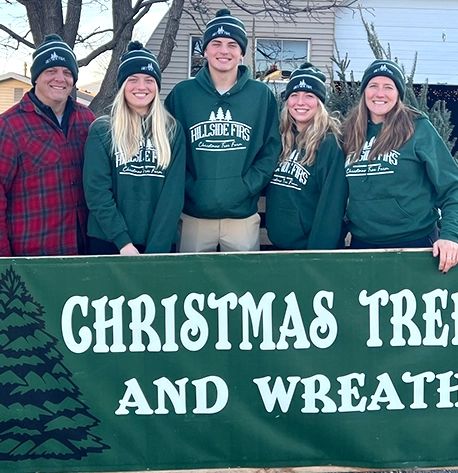
Hillside Firs begins selling their homegrown Christmas trees
By Ben Sonnek
STAFF WRITER
PLAINVIEW — What was inspired by movies has become a reality for Steve and Amy Hinrichs. After years of planting, care and maintenance — and not running over too many saplings with a lawn mower by accident — they are ready to sell Christmas trees from their Plainview farm, Hillside Firs.
“It’s a leap of faith,” Steve said. “You plant (Christmas trees) in 2017, and … they start growing a little more and a little more. It has ups and downs, and you hope that, eight years later, it’ll turn out. It’s a great feeling to get to this point.”
The Hinrichs family have owned their farm since 2010. They used to live in town but wanted to move into the country. The Hinrichs knew people who wanted to move from the country and into town, so they swapped properties.
The Christmas tree idea traces back to Amy’s mother, Lois Dankers. Before she passed away, she was a huge fan of Christmas and the corresponding Hallmark channel movies. That love passed on to Amy, and at one point during the 2016 holiday season, she and Steve had settled in for a Christmas show.
“If you watch Hallmark movies, 90% of them involve a tree farm,” Amy said. “I remember going, ‘Why don’t we do this? This is fun.’ … Nobody in Plainview has a tree lot, so the wheels started turning.”
In the spring of 2017, the Hinrichs planted over 1,000 Christmas trees in their pasture, and ever since, they have been planting 500 every year. That fall, they opened a Christmas tree lot on Broadway in Plainview. The lot and its Quonset shed belonged to Susan Atkinson, a former neighbor of the Hinrichs who also moved to the country. When Amy had posted online about selling trees off her farm, Atkinson offered the in-town site. To stock the lot while their own trees were growing, the Hinrichs purchased about 100 trees from Bob Howe, a grower by St. Charles.
Howe, along with Denny Rollman — a retired tree farm owner — have mentored the Hinrichs in getting their own tree farm started.
“We’ve been very fortunate to have two gentlemen who have taught us almost everything we know,” Amy said. “They know each other, too; it’s a small world in the world of trees.”
Through their in-town Christmas tree lot, the Hinrichs were able to test the market. They sold their 100 trees in the first year, and business stayed strong for the following years.
“There was a need in this community for a Christmas tree farm,” Steve said.
Even with the lot, the Hinrichs wanted Christmas tree purchases to be an experience, not merely a transaction.
“We did hot cocoa and played Christmas music,” Amy said. “It worked out great.”
The Hinrichs’ trees, grown under the Hillside Firs name, started around 18 inches high, and some of them are now as tall as 14 feet.
“We probably could’ve sold some last year, but we thought we’d hold off one more year,” Steve said. “We didn’t want to just have a few.”
About 95% of the trees grown at Hillside Firs are Frasier firs, and the rest include Canaan firs and balsam firs.
“The nice thing about these firs is that they all have soft needles, and they all keep their needles, even if they’ve been cut for a while,” Steve said.
Hillside Firs has also planted about 50 white pines recently, although it will be some time before they are ready.
The farm used to raise miniature horses and donkeys, and because the Hinrichs’ three children — Samantha, Abby and Alex — were in 4-H, they raised Holstein heifers and Brown Swiss cattle on their land, showing them at the Wabasha County Fair.
“We’ve tried a lot of different things,” Steve said. “We’ve tried goats, and we’ve tried chickens. As the kids were growing up, we tried all sorts of things, but when they got done showing with 4-H, we just had a big pasture there. … At one time, we had an acre of strawberries, and we did raise strawberries for … about 11-12 years, but they are so susceptible to frost and hail and bugs and too much heat. Eventually, we phased out of that.”
Growing the firs on the farm was not easy either. The land’s sandy soil did not retain water well, especially during drought years, and deer tended to nibble on the trees or rub their antlers on them, causing damage. Some trees would die for seemingly no reason. The Hinrichs put up a 6-foot-tall electric fence around the trees to keep the deer away, and both irrigation and hand-watering have been employed to combat drought.
“If you can get (the trees) to grow to about chest high, after that, they might grow 18 to 24 inches a year,” Steve said. “Finally, this year, I read enough publications from other growers who said to use mulch, and that was huge (when we used it ourselves). We’re on sandy soil; we’ve got to preserve as much moisture as possible.”
Usually in mid-July, Steve spends several weeks shearing trees to ensure they keep their shape. Lawn mowing and weed control are also key during wet months.
Now, with the trees ready, Hillside Firs opened Nov. 28 and will be open weekends as long as trees are available. Since this is the Hinrichs’ first year selling off the farm, they do not have a closing date set, and they plan on putting updates on Facebook. Decorated wreaths and porch pots will be for sale alongside the trees, and for sustenance, there will be hot cocoa, popcorn and s’mores kits, as well as the Rollin’ Smoke Shack food truck. Santa also made a visit on the opening weekend, handing out candy canes and getting pictures with visitors in the tree lot’s sled.
Unlike the lot sales, the trees will need to be cut by buyers, although the Hinrichs will help if someone needs assistance in the process. Available trees will be marked.
Once people have their trees in a stand, the Hinrichs advise getting water on the tree as soon as possible. Fresh-cut trees can absorb about a gallon of water per day, especially in their first week, before slowing down. If people wait a few days before setting up the tree, they recommend cutting off the bottom inch of the trunk before putting it in water in its stand.
“Once you have that fresh cut, it’s going to really suck up a lot of water,” Steve said. “Then, keep it away from any heat in the house.”
Next year, after the snow melts, the Hinrichs plan to plant new trees next to the stumps, and as the stump rots, it will provide nutrients to the sapling.
Moving their point of sale out to the farm was a big step for the Hinrichs, almost like starting over again, and the success of this year will likely determine how they plan the farm’s future. However, from what they have heard, their usual customers like the new venue, so there is a good chance their Christmas tree farm movie has a happy ending in store.
“People are super excited,” Amy said. “They want to come out and get the farm experience. … It’s fun to watch the kids come out, run around and pick the tree.”
By Ben Sonnek
STAFF WRITER
PLAINVIEW — What was inspired by movies has become a reality for Steve and Amy Hinrichs. After years of planting, care and maintenance — and not running over too many saplings with a lawn mower by accident — they are ready to sell Christmas trees from their Plainview farm, Hillside Firs.
“It’s a leap of faith,” Steve said. “You plant (Christmas trees) in 2017, and … they start growing a little more and a little more. It has ups and downs, and you hope that, eight years later, it’ll turn out. It’s a great feeling to get to this point.”
The Hinrichs family have owned their farm since 2010. They used to live in town but wanted to move into the country. The Hinrichs knew people who wanted to move from the country and into town, so they swapped properties.
The Christmas tree idea traces back to Amy’s mother, Lois Dankers. Before she passed away, she was a huge fan of Christmas and the corresponding Hallmark channel movies. That love passed on to Amy, and at one point during the 2016 holiday season, she and Steve had settled in for a Christmas show.
“If you watch Hallmark movies, 90% of them involve a tree farm,” Amy said. “I remember going, ‘Why don’t we do this? This is fun.’ … Nobody in Plainview has a tree lot, so the wheels started turning.”
In the spring of 2017, the Hinrichs planted over 1,000 Christmas trees in their pasture, and ever since, they have been planting 500 every year. That fall, they opened a Christmas tree lot on Broadway in Plainview. The lot and its Quonset shed belonged to Susan Atkinson, a former neighbor of the Hinrichs who also moved to the country. When Amy had posted online about selling trees off her farm, Atkinson offered the in-town site. To stock the lot while their own trees were growing, the Hinrichs purchased about 100 trees from Bob Howe, a grower by St. Charles.
Howe, along with Denny Rollman — a retired tree farm owner — have mentored the Hinrichs in getting their own tree farm started.
“We’ve been very fortunate to have two gentlemen who have taught us almost everything we know,” Amy said. “They know each other, too; it’s a small world in the world of trees.”
Through their in-town Christmas tree lot, the Hinrichs were able to test the market. They sold their 100 trees in the first year, and business stayed strong for the following years.
“There was a need in this community for a Christmas tree farm,” Steve said.
Even with the lot, the Hinrichs wanted Christmas tree purchases to be an experience, not merely a transaction.
“We did hot cocoa and played Christmas music,” Amy said. “It worked out great.”
The Hinrichs’ trees, grown under the Hillside Firs name, started around 18 inches high, and some of them are now as tall as 14 feet.
“We probably could’ve sold some last year, but we thought we’d hold off one more year,” Steve said. “We didn’t want to just have a few.”
About 95% of the trees grown at Hillside Firs are Frasier firs, and the rest include Canaan firs and balsam firs.
“The nice thing about these firs is that they all have soft needles, and they all keep their needles, even if they’ve been cut for a while,” Steve said.
Hillside Firs has also planted about 50 white pines recently, although it will be some time before they are ready.
The farm used to raise miniature horses and donkeys, and because the Hinrichs’ three children — Samantha, Abby and Alex — were in 4-H, they raised Holstein heifers and Brown Swiss cattle on their land, showing them at the Wabasha County Fair.
“We’ve tried a lot of different things,” Steve said. “We’ve tried goats, and we’ve tried chickens. As the kids were growing up, we tried all sorts of things, but when they got done showing with 4-H, we just had a big pasture there. … At one time, we had an acre of strawberries, and we did raise strawberries for … about 11-12 years, but they are so susceptible to frost and hail and bugs and too much heat. Eventually, we phased out of that.”
Growing the firs on the farm was not easy either. The land’s sandy soil did not retain water well, especially during drought years, and deer tended to nibble on the trees or rub their antlers on them, causing damage. Some trees would die for seemingly no reason. The Hinrichs put up a 6-foot-tall electric fence around the trees to keep the deer away, and both irrigation and hand-watering have been employed to combat drought.
“If you can get (the trees) to grow to about chest high, after that, they might grow 18 to 24 inches a year,” Steve said. “Finally, this year, I read enough publications from other growers who said to use mulch, and that was huge (when we used it ourselves). We’re on sandy soil; we’ve got to preserve as much moisture as possible.”
Usually in mid-July, Steve spends several weeks shearing trees to ensure they keep their shape. Lawn mowing and weed control are also key during wet months.
Now, with the trees ready, Hillside Firs opened Nov. 28 and will be open weekends as long as trees are available. Since this is the Hinrichs’ first year selling off the farm, they do not have a closing date set, and they plan on putting updates on Facebook. Decorated wreaths and porch pots will be for sale alongside the trees, and for sustenance, there will be hot cocoa, popcorn and s’mores kits, as well as the Rollin’ Smoke Shack food truck. Santa also made a visit on the opening weekend, handing out candy canes and getting pictures with visitors in the tree lot’s sled.
Unlike the lot sales, the trees will need to be cut by buyers, although the Hinrichs will help if someone needs assistance in the process. Available trees will be marked.
Once people have their trees in a stand, the Hinrichs advise getting water on the tree as soon as possible. Fresh-cut trees can absorb about a gallon of water per day, especially in their first week, before slowing down. If people wait a few days before setting up the tree, they recommend cutting off the bottom inch of the trunk before putting it in water in its stand.
“Once you have that fresh cut, it’s going to really suck up a lot of water,” Steve said. “Then, keep it away from any heat in the house.”
Next year, after the snow melts, the Hinrichs plan to plant new trees next to the stumps, and as the stump rots, it will provide nutrients to the sapling.
Moving their point of sale out to the farm was a big step for the Hinrichs, almost like starting over again, and the success of this year will likely determine how they plan the farm’s future. However, from what they have heard, their usual customers like the new venue, so there is a good chance their Christmas tree farm movie has a happy ending in store.
“People are super excited,” Amy said. “They want to come out and get the farm experience. … It’s fun to watch the kids come out, run around and pick the tree.”

